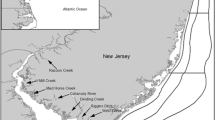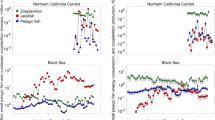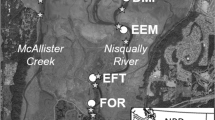Abstract
Recent studies have indicated that populations of gelatinous zooplankton may be increasing and expanding in geographic coverage, and these increases may in turn affect coastal fish populations. We conducted trawl surveys in the northern California Current and documented a substantial biomass of scyphomedusae consisting primarily of two species (Chrysaora fuscescens and Aurelia labiata). Spatial overlap of these jellyfish with most pelagic fishes, including salmon, was generally low, but there were regions of relatively high overlap where trophic interactions may have been occurring. We compared feeding ecology of jellyfish and pelagic fishes based on diet composition and found that trophic overlap was high with planktivorous species that consume copepods and euphausiid eggs such as Pacific sardines (Sardinops sagax), northern anchovy (Engraulis mordax), Pacific saury (Cololabis saira), and Pacific herring (Clupea pallasi). Moreover, isotope and diet analyses suggest that jellyfish occupy a trophic level similar to that of small pelagic fishes such as herring, sardines and northern anchovy. Thus jellyfish have the potential, given their substantial biomass, of competing with these species, especially in years with low ecosystem productivity where prey resources will be limited.





Similar content being viewed by others
References
Arai MN (1988) Interactions of fish and pelagic coelenterates. Can J Zool 66:1913–1927
Arai MN (2001) Pelagic coelenterates and eutrophication: a review. Hydrobiology 451:69–87
Atkinson A, Siegel V, Pakhomov E, Rothery P (2004) Long-term decline in krill stock and increase in salps within the Southern Ocean. Nature 432:100–103
Attrill MJ, Wright J, Edwards M (2007) Climate-related increases in jellyfish frequency suggest a more gelatinous future for the North Sea. Limnol Oceanogr 52:480–485
Bakun A, Weeks SJ (2006) Adverse feedback sequences in exploited marine systems: are deliberate interruptive actions warranted? Fish Fish 7:316–333
Branch GM (1984) Competition between marine organisms: ecological and evolutionary implications. Oceanogr Mar Biol Ann Rev 22:429–593
Brodeur RD, Mills CE, Overland JE, Walters GE, Schumacher JD (1999) Substantial increase in gelatinous zooplankton in the Bering Sea, with possible links to climate change. Fish Oceanogr 8:296–306
Brodeur RD, Sugisaki H, Hunt GL Jr (2002) Increases in jellyfish biomass in the Bering Sea: implications for the ecosystem. Mar Ecol Prog Ser 233:89–103
Case TJ, Gilpin ME (1974) Interference competition and niche theory. Proc Natl Acad Sci USA 71:3073–3077
Chan F, Barth JA, Lubchenco J, Kirincich A, Weeks H, Peterson WT, Menge BA (2008) Emergence of anoxia in the California Current large marine ecosystem. Science 319:920
Chiles J-P, Delfiner P (1999) Geostatistics: modeling spatial uncertainty. Wiley, New York
Costello JH, Colin SP (1994) Morphology, fluid motion, and predation by the scyphomedusa Aurelia aurita. Mar Biol 121:327–334
Cressie NAC (1993) Statistics for spatial data. Wiley, New York
Emmett RL, Brodeur RD, Miller TW, Pool SS, Bentley PJ, Krutzikowsky GK, McCrae J (2005) Pacific sardine (Sardinops sagax) abundance, distribution and ecological relationships in the Pacific Northwest. Calif Coop Oceanic Fish Invest Rep 46:122–143
Essington TE, Beaudreau AH, Wiedenmann J (2006) Fishing through marine food webs. Proc Natl Acad Sci 103:3171–3175
Fancett MS, Jenkins GP (1988) Predatory impact of scyphomedusae on ichthyoplankton and other zooplankton in Port Phillip Bay. J Exp Mar Biol Ecol 116:63–77
Graham WM, Bayha KM (2007) Biological invasions by marine jellyfish. In: Nentwig W (ed) Ecological studies, vol 193, biological invasions. Springer, Berlin, pp 240–255
Grantham BA, Chan F, Nielsen KJ, Fox DS, Barth JA, Huyer J, Lubchenco J, Menge BA (2004) Upwelling-driven nearshore hypoxia signals ecosystem and oceanographic changes in the northeast Pacific. Nature 429:749–754
Greene CH (1985) Planktivore functional groups and patterns of prey selection in pelagic communities. J Plankton Res 7:35–40
Johnston K, Ver Hoef JM, Krivoruchko K, Lucas N (2001) Using ArcGIS geostatistical analyst. ESRI, California
Link JS, Ford MD (2006) Widespread and persistent increase of Ctenophora in the northeast US shelf ecosystem. Mar Ecol Prog Ser 320:153–159
Lynam CP, Brierley AS (2007) Enhanced survival of 0-group gadoid fish under jellyfish umbrellas. Mar Biol 150:1397–1401
Lynam CP, Hay SJ, Brierley AS (2004) Interannual variability in abundance of North Sea jellyfish and links to the North Atlantic oscillation. Limnol Oceanog 49:637–643
Lynam CP, Hay SJ, Brierley AS (2005) Jellyfish abundance and climatic variation: contrasting responses in oceanographically distinct regions of the North Sea, and possible implications for fisheries. J Mar Biol Assoc UK 85:435–450
Lynam CP, Gibbons MJ, Axelsen BE, Sparks CAJ, Coetzee J, Heywood BG, Brierley AS (2006) Jellyfish overtake fish in a heavily fished ecosystem. Curr Biol 16:R492–R493
Madin LP (1988) Feeding behavior of tentaculate predators: in situ observations and a conceptual model. Bull Mar Sci 43:413–429
Matheron G (1971) The theory of regionalized variables and its applications. Les Cahiers du Centre de Morphologie Mathématique, Fascicule 5, Centre de Géostatistique, Fontainebleau
Miller TW (2006a) Trophic dynamics of marine nekton and zooplankton in the northern California Current pelagic ecosystem. Ph.D. Dissertation, Oregon State University, Corvallis, 212 p
Miller TW (2006b) Tissue-specific response of δ15 N in adult Pacific herring (Clupea pallasi) following an isotopic shift in diet. Environ Biol Fish 76:177–189
Miller TW, Brodeur RD (2007) Diet of and trophic relationships among dominant marine nekton within the northern California Current ecosystem. Fish Bull 105:548–559
Mills CE (2001) Jellyfish blooms: are populations increasing globally in response to changing ocean conditions? Hydrobiologia 451:55–68
Möller H (1984) Reduction of a larval herring population by jellyfish predator. Science 224:621–622
Mullon C, Fréon P, Cury P (2005) The dynamics of collapse in world fisheries. Fish Fish 6:111–120
Parsons TR, Lalli CM (2002) Jellyfish population explosions: revisiting a hypothesis of possible causes. La Mer 40:111–121
Pauly D, Christensen V, Dalsgaard J, Froese R, Torres R Jr (1998) Fishing down marine food webs. Science 279:860–863
Peterson WT et al. (2006) The state of the California Current, 2005–2006: warm in the north, cool in the south. Calif Coop Oceanic Fish Invest Rep 47:30–74
Post DM (2002) Using stable isotopes to estimate trophic position: models, methods, and assumptions. Ecology 83:703–718
Purcell JE (1985) Predation on fish eggs and larvae by pelagic cnidarians and ctenophores. Bull Mar Sci 37:739–755
Purcell JE (1989) Predation on fish larvae and eggs by the hydromedusa Aequorea victoria at a herring spawning ground in British Columbia. Can J Fish Aquat Sci 46:1415–1427
Purcell JE (1990) Soft-bodied zooplankton predators and competitors of larval herring (Clupea harengus pallasi) at herring spawning grounds in British Columbia. Can J Fish Aquat Sci 47:505–515
Purcell JE (2005) Climate effects on formation of jellyfish and ctenophore blooms. J Mar Biol Assoc UK 85:461–476
Purcell JE, Arai MN (2001) Interactions of pelagic cnidarians and ctenophores with fish: a review. Hydrobiologia 451:27–44
Purcell JE, Decker MB (2005) Effects of climate on relative predation by schyphomedusae and ctenophores on copepods in Chesapeake Bay during 1987–2000. Limnol Oceanogr 50:376–387
Purcell JE, Sturdevant MV (2001) Prey selection and dietary overlap among zooplanktivorous jellyfish and juvenile fishes in Prince William Sound, Alaska. Mar Ecol Prog Ser 210:67–83
Purcell JE, Nemazie DA, Dorsey SE, Houde ED, Gamble JC (1994) Predation mortality of bay anchovy Anchoa mitchelli eggs and larvae due to schyphomedusae and ctenophores in Chesapeake Bay. Mar Ecol Prog Ser 114:47–58
Purcell JE, Malej A, Benovi A (1999) Potential links of jellyfish to eutrophication and fisheries. In: Ecosystems at the land-sea margin: drainage basin to Coastal Sea. Coastal and Estuarine Studies 55:241–263
Purcell JE, Graham WM, Dumont HJ (2001a) Jellyfish blooms: ecological and societal importance. Developments in hydrobiology, vol 155. Kluwer, Dordrecht
Purcell JE, Breitburg DL, Decker MB, Graham WM, Youngbluth MJ, Raskoff KA (2001b) Pelagic cnidarians and ctenophores in low dissolved oxygen environments: a review. In: Rabalais NN, Turner RE (eds) Coastal hypoxia: consequences for living resources and ecosystems. American Geophysical Union, Washington DC, Coastal and Estuarine Studies 58:77–100
Purcell JE, Uye S, Lo W-T (2007) Anthropogenic causes of jellyfish blooms and their direct consequences for humans: a review. Mar Ecol Prog Ser 350:152–174
Reese DC (2005) Distribution, structure, and function of marine ecological communities in the northern California Current upwelling ecosystem. Ph.D. Dissertation, Oregon State University, Corvallis, 258 p
Reese DC, Brodeur RD (2006) Identifying and characterizing biological hotspots in the Northern California Current. Deep Sea Res II 53:291–314
Reese DC, Miller TW, Brodeur RD (2005) Community structure of near-surface zooplankton in the northern California Current in relation to oceanographic conditions. Deep Sea Res II 52:29–50
Rutherford LD Jr, Thuesen EV (2005) Metabolic performance and survival of medusae in estuarine hypoxia. Mar Ecol Prog Ser 294:189–200
Ruzicka JJ, Brodeur RD, Wainwright TC (2007) Seasonal food web models for the Oregon inner-shelf ecosystem: investigating the role of large jellyfish. Calif Coop Oceanic Fish Invest Rep 48:106–128
Schabetsberger R, Morgan CA, Brodeur RD, Potts CL, Peterson WT, Emmett RL (2003) Prey selectivity and diel feeding chronology of juvenile chinook (Oncorhynchus tshawytscha) and coho (O. kisutch) salmon in the Columbia River plume. Fish Oceanogr 12:523–540
Shenker JM (1984) Scyphomedusae in surface waters near the Oregon coast, May–August 1981. Estuar Coast Shelf Sci 19:619–632
Shiganova TA (1998) Invasion of the Black Sea by the ctenophore Mnemiopsis leidyi and recent changes in pelagic community structure. Fish Oceanogr 7:305–310
Shiganova TA, Bulgakova YV (2000) Effects of gelatinous plankton on Black Sea and Sea of Azov fish and their food resources. ICES J Mar Sci 57:641–648
Shoji J, Masuda R, Yamashita Y, Tanaka M (2005) Effect of low dissolved oxygen concentrations on behavior and predation rates of red sea bream Pagrus major larvae by the jellyfish Aurelia aurita and by juvenile Spanish mackerel Scomberomorus niphonius. Mar Biol 147:863–868
Suchman CL, Brodeur RD (2005) Abundance and distribution of large medusae in surface waters of the northern California Current. Deep Sea Res II 52:51–72
Suchman CL, Sullivan BK (2000) Effect of prey size on vulnerability of copepods to predation by the scyphomedusae Aurelia aurita and Cyanea sp. J Plankton Res 22:2289–2306
Suchman CL, Daly EA, Keister JE, Peterson WT, Brodeur RD (2008) Feeding patterns and predation potential of scyphomedusae in a highly productive upwelling region. Mar Ecol Prog Ser (in press)
Thuesen EV, Rutherford LD Jr, Brommer PL, Garrison K, Gutowska MA, Towanda T (2005) Intragel oxygen promotes hypoxia tolerance of scyphomedusae. J Exp Biol 208:2475–2482
Wallace HJ, Ramsay S (1983) Reliability in measuring diet overlap. Can J Fish Aquat Sci 40:347–351
Xian W, Kang B, Liu R (2005) Jellyfish blooms in the Yangtze Estuary. Science 307:41
Acknowledgments
We express our thanks to S. Pool (Oregon State University) for help on the database management, Drs. Chris Harvey and Ed Casillas (NWFSC, NMFS), Jennifer Purcell (Sea Pen Scientific Writing LLC), and three anonymous reviewers for helpful comments on the manuscript. Funding was provided by the US GLOBEC Northeast Pacific Program and the Bonneville Power Administration. This is GLOBEC Contribution number 592.
Author information
Authors and Affiliations
Corresponding author
Additional information
Communicated by B.S. Stewart.
Rights and permissions
About this article
Cite this article
Brodeur, R.D., Suchman, C.L., Reese, D.C. et al. Spatial overlap and trophic interactions between pelagic fish and large jellyfish in the northern California Current. Mar Biol 154, 649–659 (2008). https://doi.org/10.1007/s00227-008-0958-3
Received:
Accepted:
Published:
Issue Date:
DOI: https://doi.org/10.1007/s00227-008-0958-3




